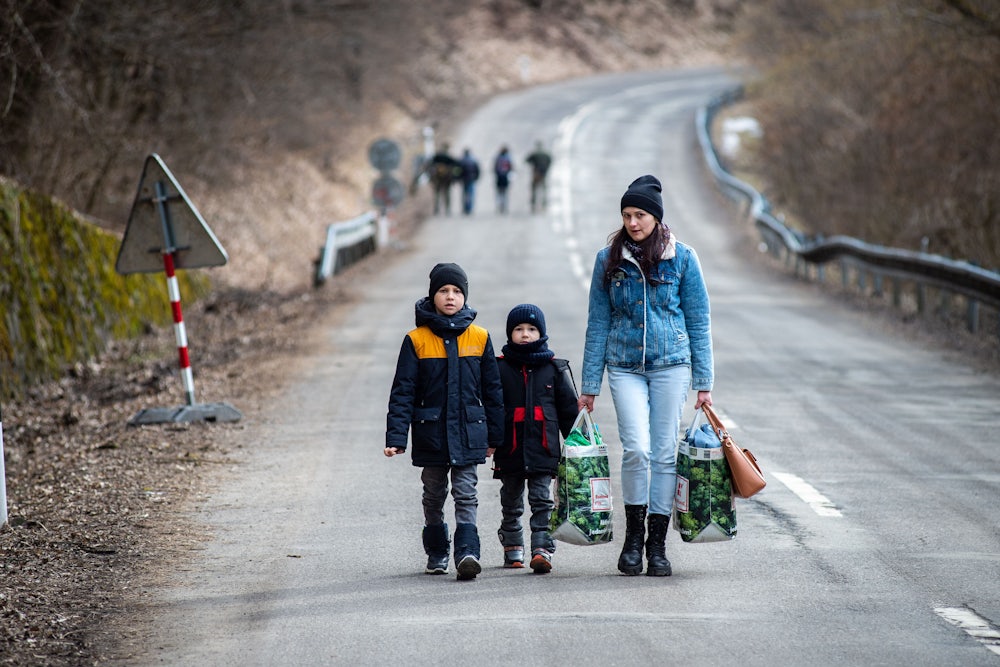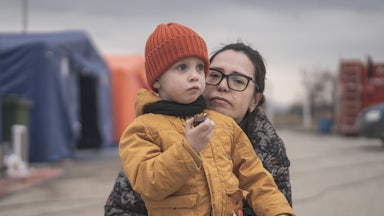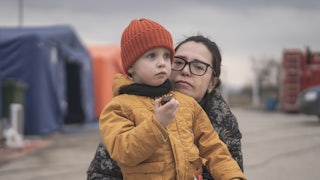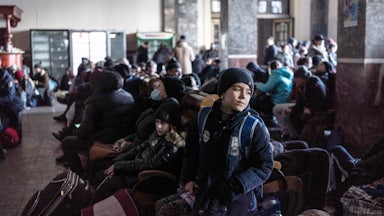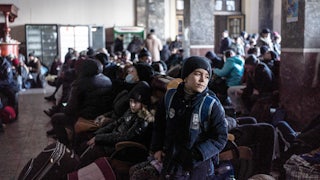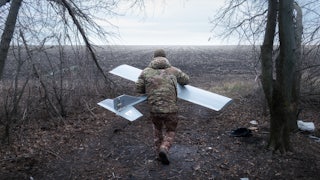As displaced Ukrainians continue to pour out of their besieged country, which has become a theater of war since Russian President Vladimir Putin launched a full invasion late last month, observers in the United States have wondered whether a significant number of refugees could end up here, in keeping with our well-established—though far from equitable—reputation as a haven for the globally wretched. The extent to and manner in which a wave of Ukrainian refugees may reach U.S. shores depends on a number of still open questions, but there are a few plausible chains of events.
Broadly speaking, there are three conceivable scenarios that could arise. In one, there ends up being no long-term need for a large volume of Ukrainians to flee their homeland. This would almost certainly entail a Russian failure to occupy the country; for example, if Ukrainian defense forces are able to fight them to a protracted stalemate and Putin is eventually forced to withdraw from what would become a militarily and politically unsustainable open-ended war front.
Some number of the millions who have already left may have, by then, achieved permanent status elsewhere and could decide to stay, but in all likelihood the majority would return to rebuild as soon as it is safe to do so, particularly if this conflict culminates with Ukraine joining NATO—an enormous deterrence to any subsequent Russian military aggression.
But there are no guarantees that Russian forces will be so easily repelled. So in a second possibility, there is a permanent exodus from Ukraine in the low millions, up to some undefined threshold that Europe would be able to absorb. This might happen in a scenario where Russia is able to gain the upper hand in the short term, capture key cities, including Kyiv, topple the Ukrainian government, and consolidate its grip. This would be an absolute loss for Ukraine but halt the street-fighting and bombardments that are probably the key drivers of current out-migration.
The flow of Ukrainian refugees into Europe—which the United Nations already pegs at over two million in the last week, mostly into Poland—differs in several key ways from the largely Middle Eastern and Asian refugee flows that have shaped European domestic politics in the last few years. European countries seem much more comfortable with, and enthusiastic about, the prospect of integrating fellow Europeans. This has been typified by the Polish government and volunteers setting up welcome centers and literally rebuilding train tracks to ferry Ukrainian refugees into the country at the same time as border guards are empowered to violate international law and immediately expel other migrants. Even now, in the Ukrainian refugee outflows, there are plenty of reports of discrimination against African and Indian students and workers caught up in the crowds fleeing the violence of the invasion.
Ukrainians also have some specific legal advantages. As of several years ago, they’ve enjoyed visa-free travel to EU countries, facilitating their ability to reach any country where they may already have connections. The EU has relaxed certain border controls, allowing Ukrainians to enter even without a passport, and is now set to enact a never-before-used provision known as a Temporary Protection Directive, which would grant Ukrainians residency permits for up to three years. Once in the EU, they can seek a variety of more permanent statuses relatively easily—so easily in fact that some experts contend there will be relatively few asylum applicants at all, with most Ukrainians finding other avenues to stay in EU countries.
In effect, this would be a refugee influx without the usual trappings of refugee processing: no squalid camps, no lengthy legal processes or uncertain statuses. If the number of refugees remains at a certain threshold, it will be a more straightforward mass migration with theoretically little friction, of the sort we’re already seeing spreading throughout Europe.
That starts breaking down in the third scenario, in which there’s a much larger number of refugees, which begins to strain Europe’s ability and desire to accommodate them. Such a situation seems likeliest to develop in the event that Russia, frustrated by its lack of advance and the collapse of its attempted blitzkrieg, resorts to heavy-handed and indiscriminate attacks in which civilian targets are either incidentally or intentionally struck by Russian forces.
Unfortunately, there are already some troubling indications of this precise strategy shift, with an increase in documented instances of Russian strikes on civilian infrastructure and reports of its use of potent thermobaric weapons in cities. A vicious and prolonged campaign to break Ukrainian morale will, as a matter of course, drive many more people to leave the country. At a certain volume and over a long enough period of time, the warm welcome of those fleeing the carnage and chaos will inevitably wear thin.
Domestic political audiences, no matter how initially eager to receive refugee populations, will always eventually tire, particularly as narratives develop over the provision of social services and the unavoidable temporary stretching of public programs that tends to accompany these arrivals. If the Ukrainian refugee population starts heading into the four, five, or six million range, it’s possible they’ll overwhelm Europe’s practical or political capacity to welcome them in full.
This is where the U.S. is likely to step in. The Ukrainian-American community and several lawmakers are calling for the U.S. to be more meticulous and preemptive in setting up resettlement processes for Ukrainian refugees, taking lessons from its disastrously botched efforts to evacuate Afghans following last year’s withdrawal. The administration has already moved aggressively to protect Ukrainians, taking just one week from the start of the invasion to designate the country for Temporary Protected Status, giving all Ukrainians currently in the U.S. a potential shield from deportation, and the ability to obtain work permits regardless of their prior status.
U.S. Immigration and Customs Enforcement almost simultaneously announced that it was suspending deportation flights not only to Ukraine and Russia but also to Belarus, Georgia, Hungary, Moldova, Poland, Romania, and Slovakia, an unprecedented regional deportation pause intended to allow these countries to receive refugees without having to worry about accommodating deportees as well.
In a little-noticed move, the State Department formally designated Ukrainians as “homeless visa applicants,” an acknowledgment that they cannot be expected to apply for immigrant visas from Ukraine itself. Instead, consular staff in Frankfurt and Warsaw will now be empowered to process Ukrainians’ U.S. visa applications, a potential precursor to the ramping up of refugee processing capacity in those locations, were they to become necessary.
In practice, would-be refugees would have to be referred to the U.S. refugee program, probably by the U.N., and then spend one or two years in the convoluted refugee pipeline, filling out onerous paperwork and receiving in-depth background and medical checks. It’s unclear where exactly most of this processing would take place, but Warsaw is a good bet given the sheer volume of arrivals to Poland. Warsaw already handles processing for Russian and Belarusian visa applicants, so this would likely require the State Department to greatly increase its consular staff there.
One possible sticking point would be the volume of Ukrainian civilians who have now received military training and engaged in some form of combat, which could trip security flags for refugee applications. Given how widespread that’s been, it’s possible that the federal government could issue generalized waivers, a move that’s exponentially more plausible for Ukrainians than, say, Syrians who had joined armed groups in opposition to Bashar Al Assad, even if both received direct military assistance from the U.S.
There’s surprisingly ample recent precedent for Ukrainian refugee arrivals stateside. It’s often overlooked that, during the Trump years, Ukrainians were actually in the top three nationalities for refugee arrivals in the U.S., outnumbering Syrians 8 to 1 and Afghans 4 to 1. While Russia had by then annexed Crimea and there was internal strife in the Donbas region, these refugees largely weren’t escaping conflict. They were ostensibly religious refugees, many of them evangelical or Baptist Christians who benefited from an obscure provision known as the Lautenberg Amendment, intended to allow a lower evidentiary bar for religiously persecuted citizens of the former Soviet Union to seek refugee status in the U.S.
Some 4,400 Ukrainian refugees arrived in the U.S. in fiscal year 2019, making up about 15 percent of the already low refugee arrivals. Another 1,900 arrived in fiscal 2020, for a total of 16 percent of admissions. Their overrepresentation was mainly due to Trump officials’ rather evident distaste for Muslim refugees and favoritism for white Christians, which the Ukrainians effectively all were. Now, with Biden having ramped up the fiscal 2022 refugee cap to 125,000, just keeping prior proportions more or less the same, the U.S. could resettle some 20,000 Ukrainians.
The new administration isn’t anywhere near as openly antagonistic to other types of refugees as the prior one, but the fact remains that Ukrainian resettlements are politically popular in a way that Afghan or Syrian resettlements simply are not. Some of the same Republican elected officials who inveighed against the supposed dangers of Afghan refugees and Central American asylum-seekers are now pushing for substantial Ukrainian resettlement efforts.
It’s a safer political bet for Biden to go all in on welcoming displaced Ukrainians to these shores; the idea enjoys widespread backing and will provide some annoyance to Putin, as well. For that reason alone, paired with the unfortunately increasing likelihood that Putin will resort to heavy-handed and wholesale violence in Ukraine, a large volume of arrivals seems decently probable.
They will be welcomed with open arms and ample government support, in large part because of who they are: people white suburban voters see themselves reflected in or, as oblivious newscasters might put it, “civilized” folk. Whether these charitable impulses toward Ukrainians result in more equitable impulses toward other refugees fleeing violence, is, of course, not as likely.
